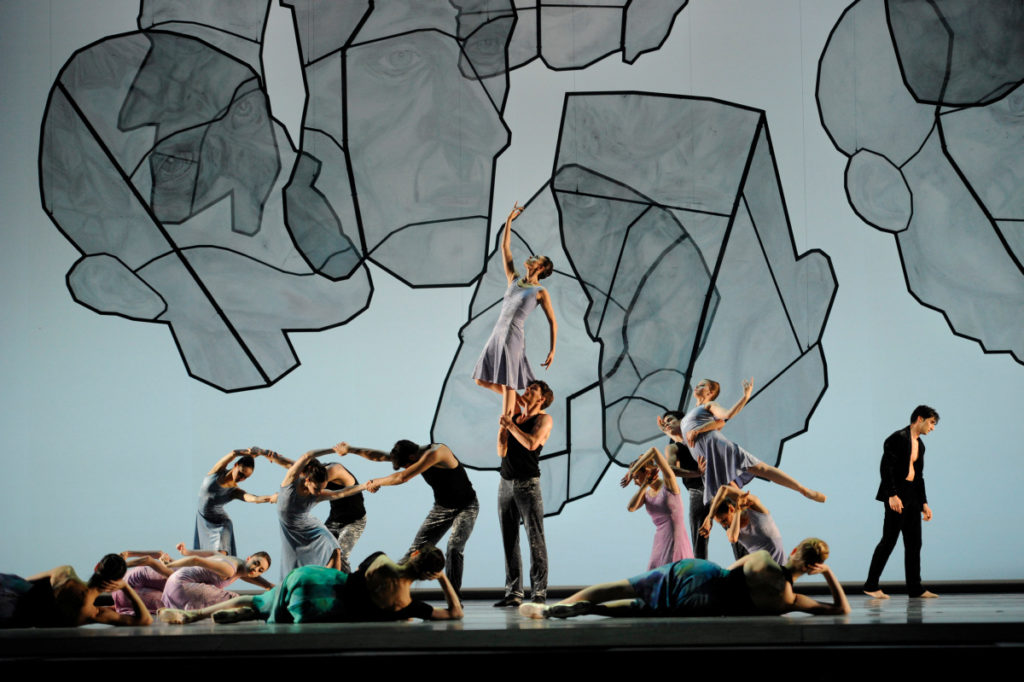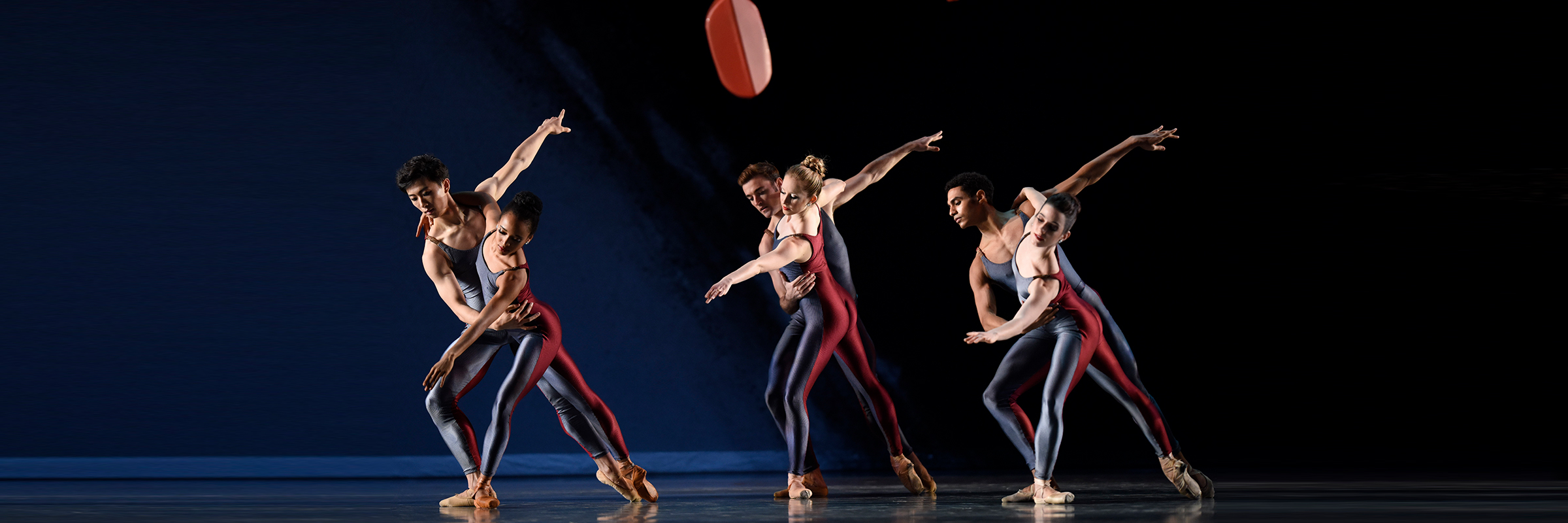About Alexei Ratmansky’s Shostakovich Trilogy
An Exploration of the Most Fundamental Human Emotions
Often not particularly melodic, with rapid-fire shifts in tone and tempo, Dmitri Shostakovich’s music seems more suited for concert halls and film scores than for the ballet stage. But in the hands of choreographer Alexei Ratmansky, this music is danceable indeed. Shostakovich Trilogy, a co-production of San Francisco Ballet and American Ballet Theatre (ABT), consists of three discrete ballets conceived to be performed together. Like George Balanchine’s Jewels, the three ballets complement one another, producing their full impact when seen together. Yet each multifaceted dance sparkles on its own.
SF Ballet Artistic Director and Principal Choreographer Helgi Tomasson’s first reaction to Ratmansky’s concept was admiration “for going with the same composer for the whole evening,” he says. “Shostakovich is not nearly as familiar to most audiences as other composers. And to use a little bit of his life story—I was very taken by that. If anybody could do it, it would be Alexei.” Certainly no other choreographer has shown as much dedication to Shostakovich as Ratmansky, who has set at least 11 ballets to the composer’s music.
To appreciate any music, it’s best to grasp the context of the times in which the composer worked. That’s particularly true of Shostakovich. Coming of age in Stalinist Russia, he, like all artists, was under scrutiny. He gained celebrity at an early age, and political expectations followed in the form of requests for compositions that exalted the Soviet state. Often he rebelled, and several times he was denounced by the state; he walked a tightrope between survival and artistic choice. “Stalin was interested in music that celebrated everything that was great about Russia, and Shostakovich was at odds with that,” says Music Director and Principal Conductor Martin West. “He was trying to create music for all time, not just for Russia.”
Ratmansky, though, had Russia in mind when he created Shostakovich Trilogy, according to stager and ABT Ballet Master Nancy Raffa. “This is an homage to Shostakovich, because of Alexei’s enormous admiration for his talent and for what he symbolizes for Russian people,” she says. “But it’s also an homage to [Ratmansky’s] heritage. He grew up listening to and loving Shostakovich, so this was like a gift [to the composer]. And a gift to Russia.”
Permeating these ballets are the most fundamental human emotions: love and euphoria, grief and despair, and deeply, pervasively, fear—of being watched or followed, or (we assume) disappeared, as so often happened to those in political disfavor during Shostakovich’s lifetime. The color red is prominent; backdrops offer hints of Stalin-era Russia. Yet all three ballets are markedly different.
Symphony #9

In creating Symphony #9, Raffa says, Ratmansky considered “the time the piece was written and the emotions behind what was happening in Shostakovich’s life.” The first principal couple represents Shostakovich and his wife, supporting each other in a time of great danger; the other couple represents “the regime, the communist party, the whole Stalin mentality,” Raffa says. “He wanted them to be almost a caricature, expressing the sarcasm in parts of the score. But everything is abstract. He kept saying, ‘There’s no story, but there’s a lot of meaning.’”
West calls Shostakovich’s ninth symphony “so much fun—it goes by like the wind.” Fun and flashy it is, but it was also was one of the composer’s acts of rebellion. West explains: “When the war was finished, it was agreed that he would write a Beethoven’s Ninth type of thing, to celebrate the beating of the Nazis. He started writing it and scrapped it.” What he wrote instead—this funny, acerbic symphony—was interpreted as thumbing his nose at Stalin. “He was in big trouble,” West says. “They were expecting something triumphal and this is just a bit of fun. [In places] it’s like he’s mocking Stalin. I don’t know if he was, but that’s the feeling you get.”
In Ratmansky’s hands, tension underlies the fun, giving the ballet an edge of fear. The subtext is clear: no one is safe. Raffa tells one couple, “You’re running away from something. The arm is like a window—lookthrough it.” Yet the ballet is buoyed by hope, manifested by a solo principal man Ratmansky calls the Angel. “He’s symbolic of something beyond our tangible, physical world,” Raffa says. “He’s a guide. Despite the turmoil that somebody could live [through], there’s always a way through it. That dancer is symbolic of this.” She tells the Angel dancer to “come out like you’re attacking all the evil. That means you can’t touch the ground. Come out like fire.”
There is always, Raffa says, the “guidance of your own integrity, your value system. Of hope, where there’s perhaps no hope; light where there’s only darkness.”
Chamber Symphony

Chamber Symphony is as close to a narrative ballet as the trilogy gets. The lead man is Shostakovich and the three principal women are his loves—the girl he was infatuated with but never made time for, the wife (and mother of his children) whose death undid him, and the young wife who shared his later years. The ballet takes the form of a retrospective—again with the constancy of fear, this time referencing the persecution of the Jews. (Note the Jewish theme in the music, and the fragments of folk dancing.) Loss weighs heavily in this ballet—of loved ones and what Shostakovich risked to be the artist he wanted to be.
In making this ballet, Ratmansky was responding to the well-documented fact that Shostakovich’s Chamber Symphony, an orchestration of his Quartet No. 8, was intensely personal to the composer. He quotes his own music here more than anywhere else, and each movement bears an insistent theme—his signature, “DSCH (D.Sch.),” letters in his name (written in German) that can be played as musical notes. The piece, which includes part of an old Russian prison song, was Shostakovich’s personal protest (the dedication reads, “In Memory of Victims of Fascism and War”), he said. Various sources claim that he said this music could serve as his epitaph.
The way Principal Dancer Mathilde Froustey sees it, “we are what Shostakovich wanted to create. There is a kind of double sense—we are the instruments of Alexei and Shostakovich. There is the choreography, and there is the music. There is the context of the creation of this music.” There’s a moment in this ballet when the Shostakovich character raises a finger in a moment of recognition. Raffa says it’s as if he’s thinking, “Everything I’ve lived through had a purpose, a meaning. I can pass peacefully now because I’ve left something.” In the final tableau, she says, Ratmansky builds an image that pulls the viewers’ eyes up, to a single woman held high, as if to say “what he left is monumental. The scene is like a monument to Shostakovich’s thoughts and ideas, his humanness.”
Piano Concerto #1

Piano Concerto #1 is the most abstract ballet in the trilogy; Ratmansky is “using the dancers as instruments, creating the music with their movement,” Nancy Raffa says. Yet there’s visible emotion. “Shostakovich is extremely emotional,” Raffa says. “You can’t work with his music and not have that quality in your choreography.”
The music, Concerto No. 1 for Piano, Trumpet, and Strings, is mercurial, whipping from one mood to another. West describes the piece as “a very good example of classic proportions where Shostakovich was able to take off on tangents that only a great comedy genius could do. Especially the last movement—it goes nuts. Suddenly he slams on a chord out of nowhere, or he’ll make it sound like he’s going to trill into a little Mozart cadenza [embellishment] and then doesn’t.” That frantic quality in the last movement may have roots in Shostakovich’s youth, when he played piano accompaniment for silent movies. “He was able to make stuff up,” West says. “That’s almost how this concerto is—it’s a ridiculous play on everything.” Yet it has “all styles of music, very deep and serious,” he says, “and the slow movements are beautiful.”
Principal Dancer Vitor Luiz says he loves the contrast in the music, especially during a solo he dances. “The music shifts to this very energetic movement—it’s like showing off—and then it goes back to quiet. It’s theatrical. The image Nancy gave us was of looking out a window to see your future, but you don’t see any future there. That already gives you the idea why you do that solo—because you have nowhere to go,” he says. “If you do this solo right, it will touch people’s souls.”
What’s remarkable about dancing Ratmansky’s ballets, Luiz says, is that “they make you feel good.” Ratmansky shared “his knowledge and his deep attention to details. He said, ‘It’s like fine cuisine. You have to put in all these ingredients, and they are all measured in grams. You have to use all that.’
“The image Alexei wanted is a prisoner in a country,” continues Luiz, “the artists who couldn’t get out. Nancy said, ‘Imagine that you cannot go back to Brazil, and your whole family is there—your daughter, everyone—and you can’t ever talk to them again.’ And so in this moment that’s what you think. You’re trying to find a solution or a way out, and you can’t. Every movement has a meaning. Maybe that’s why you feel good afterward—because you feel like you accomplished something technically but also artistically.”
By Cheryl A. Ossola
Header image: San Francisco Ballet in Ratmansky's Shostakovich Trilogy // © Erik Tomasson








